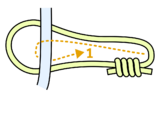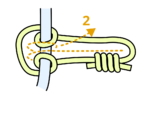Prusik knot: Difference between revisions
| Line 25: | Line 25: | ||
''this section is not yet inspected thoroughly, statements might be incorrect and/or misleading!'' | ''this section is not yet inspected thoroughly, statements might be incorrect and/or misleading!'' | ||
Based on the cord load limits 5 mm (5.1 kN) or 6 mm (10 kN) reep cord is generally recommended for tying prusiks.<ref>{{cite web | url=https://www.mytendon.com/en/products/accessories/accessory-cords/c-23/ | title=Acessory cords | publisher=LANEX a.s. | author=LANEX a.s. | website=tendon.cz | access-date=16 August 2025}}</ref> General rule of a thumb is that for prusik to block readily, it is recommended if it is 1/2 diameter of the rope on which its supposed to be tied. For a standard climbing rope (~9.7 mm), I personally recommend to use 6 mm | Based on the cord load limits 5 mm (5.1 kN) or 6 mm (10 kN) reep cord is generally recommended for tying prusiks.<ref>{{cite web | url=https://www.mytendon.com/en/products/accessories/accessory-cords/c-23/ | title=Acessory cords | publisher=LANEX a.s. | author=LANEX a.s. | website=tendon.cz | access-date=16 August 2025}}</ref> General rule of a thumb is that for prusik to block readily, it is recommended if it is 1/2 diameter of the rope on which its supposed to be tied. For a standard climbing rope (~9.7 mm), I personally recommend to use 6 mm cord for the prusiks as long as it blocks properly. It is much easier to loosen and the loading capacity of the cord is substantially better compared to the 5mm. | ||
== References == | == References == | ||
Revision as of 16:38, 16 August 2025
| Prusik knot | |
|---|---|
 | |
| Other names | Prusik, prusik hitch |
| Use(s) | abseiling, advanced rope techniques including (self-)rescue techniques |
| Pros | Fast, clean, just an accessory cord or a sling needed |
| Cons | Compared to traxion, tiblocs and such it is a bit tedious to get loosen in some cases and it must be moved actively |
| Category | Hitch |
| Strength | ~5-8 kN when a 5-7mm accessory cord is used[1] |
Prusik knot (technically a hitch) is a very versatile hitch used in abseiling, pulley systems, prusiking up the ropes. In some of the applications it can be replaced by tibloc and various traxions and similar devices which provides improved comfort of use by unidirectionally moving seamlessly on the rope while providing the same stopping functionality as prusik.
Tying
Steps description: Wrap an accessory cord around a rope as illustrated (1), do it two more times (2), pull the rest of the accessory cord loop to dress the prusik (3) and try if it blocks properly (4) and visually inspect if everything looks as it should (5).
Diameter recommendations
this section is not yet inspected thoroughly, statements might be incorrect and/or misleading!
Based on the cord load limits 5 mm (5.1 kN) or 6 mm (10 kN) reep cord is generally recommended for tying prusiks.[2] General rule of a thumb is that for prusik to block readily, it is recommended if it is 1/2 diameter of the rope on which its supposed to be tied. For a standard climbing rope (~9.7 mm), I personally recommend to use 6 mm cord for the prusiks as long as it blocks properly. It is much easier to loosen and the loading capacity of the cord is substantially better compared to the 5mm.
References
- ↑ Jenks, Ryan (16 June 2021). Prusik, Auto Blocks, and Klemheist Break Tests. HowNOT2. Retrieved 16 August 2025.
- ↑ LANEX a.s. "Acessory cords". tendon.cz. LANEX a.s. Retrieved 16 August 2025.




